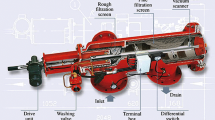Abstract
Reduction in concentration of mechanical impurities is evaluated in the circulating flow of cleaned water, some of which has been passed through a hydrocyclone.
A procedure for calculating the extent to which the solid phase is extracted into a slime-receiving bin is proposed for development of the hydrocyclone plant.
Similar content being viewed by others
REFERENCES
B. G. Kalashnikov, O. V. Pirogova, D. A. Baranov, and M. G. Lagutkin, “Separation of low-concentration disperse systems in hydrocyclones with a receiving bin,” Khim. Neft. Mashinostr., No. 1, 55–56 (1996).
I. G. Ternovskii and A. M. Kutepov, Hydrocycloning [in Russian], Nauka, Moscow (1994).
D. A. Baranov, A. M. Kutepov, and M. G. Lagutkin, “ Analysis of separation processes in hydrocyclones, ” Teor. Osn. Khim. Tekhnol., 30, No. 2, 117–122 (1996).
A. I. Povarov, Hydrocyclones in Concentrating Mills [in Russian], Nedra, Moscow (1978).
Author information
Authors and Affiliations
Additional information
Translated from Khimicheskoe i Neftegazovoe Mashinostroenie, No. 11, pp. 3–5, November, 2004.
Rights and permissions
About this article
Cite this article
Lagutkin, M.G., Bulychev, S.Y. & Pigarev, V.M. Use of hydrocyclones with a receiving bin for cleaning circulating water of mechanical impurities. Chem Petrol Eng 40, 645–650 (2004). https://doi.org/10.1007/s10556-005-0025-6
Issue Date:
DOI: https://doi.org/10.1007/s10556-005-0025-6




